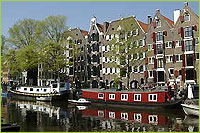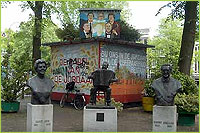| |
 |
|
Jordaan
The Jordaan was build at the large expansion of Amsterdam in early 17th century, as
a district for the working class and emigrants. The population increase during the next centuries was enormously, caused by the stream political refugees like protestant
Fleming, Spanish and Portuguese Jews and French Huguenots who mainly settled in
the Jordaan. It was a poor district with small houses and slums, every little room stuffed
with families and lots of children. The entire area was one ghetto with open sewers,
canals served for both transport and sewer, and no running water. Around 1900 there
lived about
80 thousand people, nowadays about 20 thousand.
During the seventieth of the 20th century the city council had serious plans to mainly
demolish big parts of the district and replace them for large ugly blocks of modern
buildings. There where many protests against this idea. City protectors, such as
Monument Care, where against the loss of the historical town and the people of the
Jordaan feared for large rent increases. Thanks to this resistance the plan was modified,
there came small-scale projects which would repair the neighborhood, without damaging
its original character.
A large renovation was started. By then the district was discovered
by a new generation occupants: artists, students, and young entrepreneurs. The old inhabitants moved to
other neighborhoods and cities like Almere. Partly by these new inhabitants the Jordaan
has changed from a slum area to a district for artist, still living
on low rent, and the rich
who bought the very expensive renovated houses. Nowadays
the Jordaan is compared
to the rest of the town an oasis of peace with a labyrinth of
narrow streets and little canals, nice for strolling around courtyards, art studios, and monumental buildings with stone
tablets, old-fashioned ‘brown' pubs, boutiques or
galleries.
There are also some markets in this area. Saturdays you will find the
Lindenmarkt (Lime market), a general market, on the Lindengracht (Lime canal) and
a biological food market on the Noordermarkt (North market). Mondays you have a flea market at the Noordermarkt and a market on the Westerstraat (West street) with nice
fabrics. On the Noordermarkt you can visit the Noorderkerk (North church), designed by Hendrick de Keyser in the 17th century.
|





